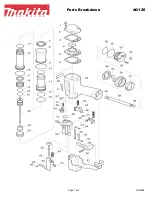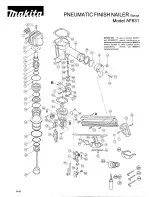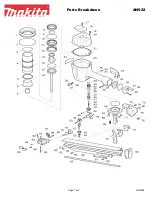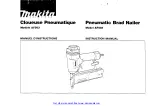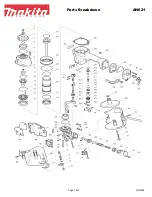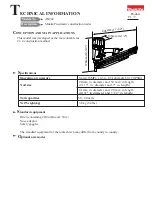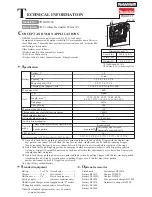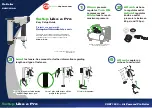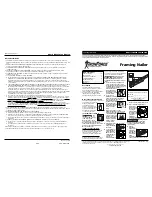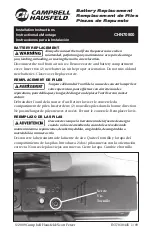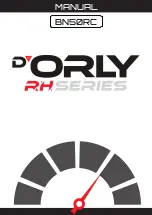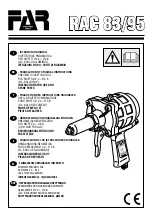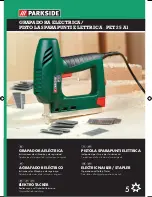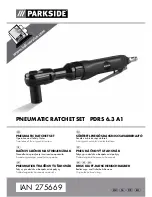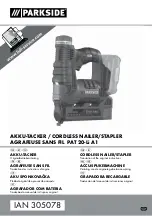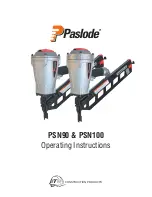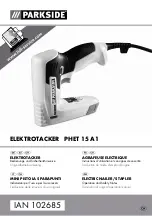
DESCRIPTION OF SYMBOLS
SPARE PARTS
AIR RANDOM
ORBITAL SANDER
150mm (6”)
INSTRUCTION MANUAL
SPECIFICATIONS
ASR-150
Sanding Pad Size:
150mm (6”)
Max. Air Pressure:
91psi (6.3Bar)
Average Air Consumption: 113 l/min (4cfm)
No Load Speed:
10,000/min
Air Inlet:
1/4” BSP
Weight:
1.73kg
Spare parts can be ordered from the Special Orders
Desk at your local Bunnings Warehouse.
For further information, or any parts not listed here, visit
www.ozito.com.au or contact Ozito Customer Service:
Australia 1800 069 486
New Zealand 0508 069 486
Email: [email protected]
GENERAL AIR TOOL SAFETY WARNINGS
AIR SANDER SAFETY WARNINGS
WARNING!
Read all safety warnings and all instructions. Failure to follow the
warnings and instructions may result in electric shock, fire and/or serious injury.
Save all warnings and instructions for future reference. The term “power tool” in the warnings
refers to your mains-operated (corded) power tool or battery-operated (cordless) power tool.
1. Work area safety
a.
Keep work area clean and well lit.
Cluttered or dark areas invite accidents.
b.
Do not operate power tools in explosive atmospheres, such as in the presence of
flammable liquids, gases or dust.
Power tools create sparks which may ignite the dust
or fumes.
c.
Keep children and bystanders away while operating a power tool.
Distractions can
cause you to lose control.
d.
Dress properly. Do not wear loose clothing or jewellery. Keep your hair, clothing
and gloves away from moving parts.
Loose clothes, jewellery or long hair can be
caught in moving parts.
e. Check the maximum pressure rating of any tools or accessories that you intend using with
the compressor. The output pressure of the air from the compressor must be regulated so
that it never exceeds the rated pressure of the tool or accessory.
f. Always wear safety goggles or glasses when using the air compressor. Never point the
nozzle of an accessory towards any part of your body or towards another person.
g.
Drain the moisture from the tank daily.
It will help prevent corrosion.
h. Use safety equipment including safety goggles or shield, ear protection, breathing respirator
mask and protective clothing.
i. Air tools should not be used in a potentially explosive environment.
j. Use safety equipment including safety goggles or shield, ear protection, breathing or
respirator mask and protective clothing.
k.
The tool must be used only for its prescribed purpose.
Any use other than those mentioned
in this Manual will be considered a case of misuse. The user and not the manufacturer
shall be liable for any damage or injury resulting from such cases of misuse.
WARNING!
In the event that an air line is cut or broken, the air supply must be turned off
at the compressor. A broken air line which is not supported is extremely dangerous and
can whip around very quickly, both with the capability of striking people, and blowing foreign
particles into the air.
Do not attempt to catch the air line but immediately keep bystanders well clear and turn off the air
supply to the hose, turn off the compressor at the On / Off button, and then remove the hose from
the compressor.
This appliance is not intended for use by persons (including children) with reduced
physical, sensory or mental capabilities, or lack of experience and knowledge, unless they
have been given the supervision or instruction concerning use of the appliance by a person
responsible for their safety.
Children should be supervised to ensure that they do not play with the appliance.
Warning
Read instruction
manual
Wear eye protection
No load speed
Wear ear protection
Revolutions or
reciprocation per minute
/min
n
o
•
Do not use sandpaper intended for larger sanding pads.
Larger sandpaper will extend
beyond the sanding pad causing snagging, tearing of the paper or kick-back.
Extra paper extending beyond the sanding pad can also cause serious lacerations.
WARNING!
Some dust created by power sanding, sawing, grinding, drilling and other construction
activities contain chemicals known to cause cancer, birth defects or other reproductive harm.
Some examples of these chemicals are:
•
Lead from lead-based paints;
•
Crystalline silica from bricks, cement and other masonry products, and;
•
Arsenic and chromium from chemically-treated timber.
Your risk from these exposures varies, depending on how often you do this type of work. To
reduce your exposure to these chemicals: work in a well ventilated area and work with approved
safety equipment, such as dust masks that are specially designed to filter out microscopic
particles.
1 Sanding Pad
2 Spindle
3 Air Regulator
4 On/Off Trigger
5 Handle
6 Air Inlet (1/4” Nitto Fitting)
KNOW YOUR PRODUCT
WARNING!
•
Disconnect the sander before changing accessories.
Accidental start-ups may
occur if the sander is plugged in while changing an accessory.
•
Disposing of dust.
Be extremely careful of dust disposal, materials in fine particle form
may be explosive. Do not throw sanding dust on an open fire. Spontaneous combustion, may
in time, result from a mixture of oil or water with dust particles.
•
Always wear eye protection and a dust mask for dusty applications and when
sanding overhead.
Sanding particles can be absorbed by your eyes and inhaled easily and
may cause health complications.
•
Use special precautions when sanding chemically pressure treated timber, paint that
may be lead based, or any other materials that may contain carcinogens.
A suitable
breathing respirator and protective clothing must be worn by all persons entering the work
area. Work should be sealed by plastic sheeting and persons not protected should be kept out
until work area is thoroughly cleaned.
•
Do not ‘wet sand’ with this sander.
•
Never place your hands near rotating components.
Accessory may kickback over your
hand.



